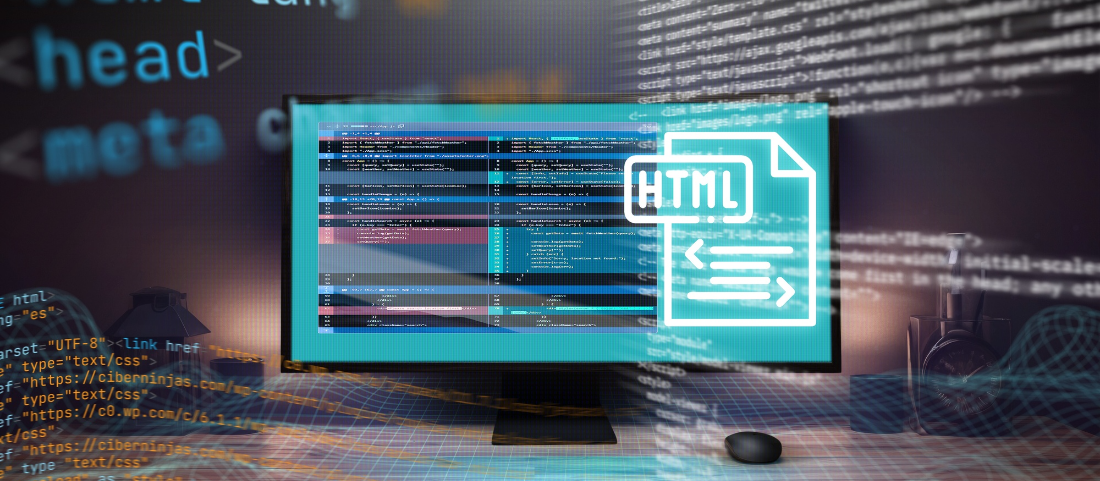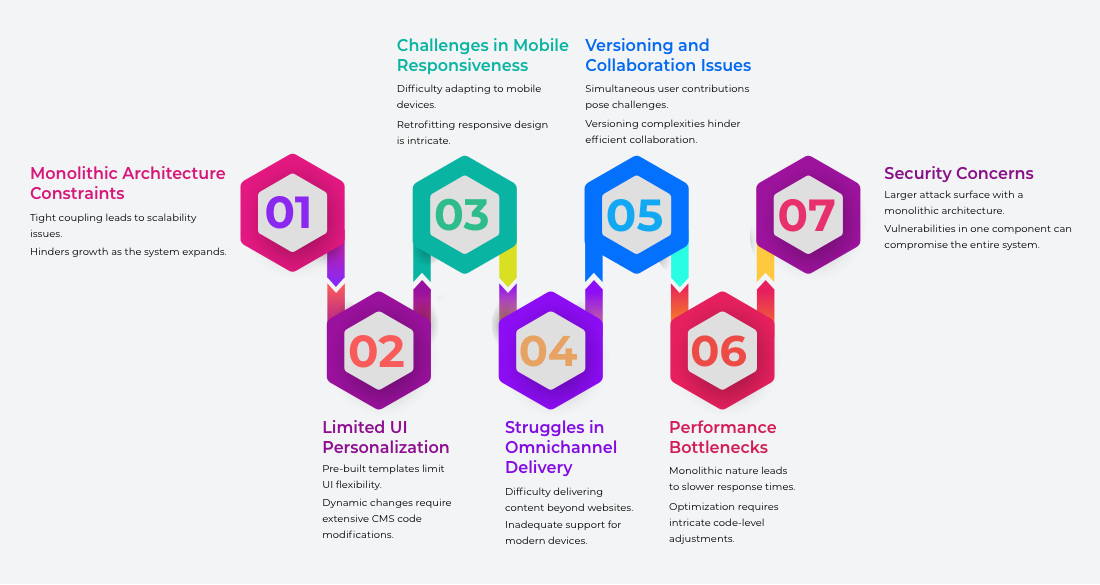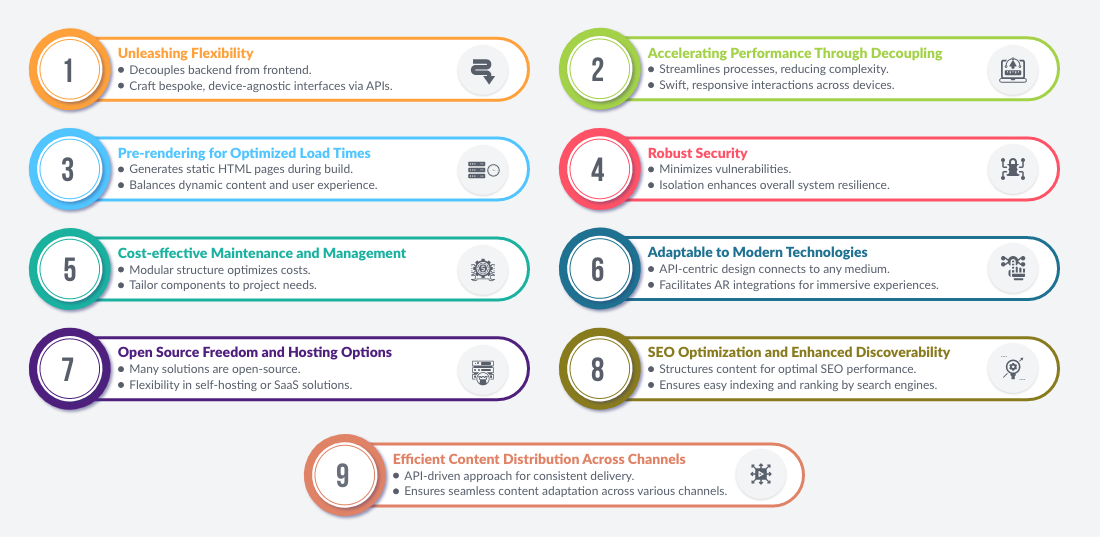Evolution from manual management to headless CMS (Content Management Systems): Blog 2 of 4
Published January 22, 2024. 6 min read
In our previous blog, we touched on the challenges of early web development, recognized the imperative need for a content management system (CMS), and witnessed the ascent of traditional CMS, which empowered content creators and facilitated expansive web growth. As promised, we are here with more detailed insights on:
- Early web development challenges
- The evolution of traditional CMS
- Traditional CMS architecture and benefits
- Challenges with traditional CMS
- Emergence of headless CMS
- Scrutiny of headless CMS architecture and its benefits
- Exploration of contemporary CMS trends
Early web development landscape
In the early days of the Internet, the challenges were rooted in the static nature of Web 1.0. HTML was the primary language for content creation, but updates were cumbersome, relying on manual copying of HTML files via FTP. This made collaboration difficult, as multiple authors couldn't easily contribute. The exclusive reliance on coding experts restricted the broader participation of non-technical individuals in content creation. These challenges created barriers to efficient content management and hindered the democratization of the content creation process.
Need for a traditional CMS
To overcome the challenges of early web development, there was a gradual shift towards dynamic content. Technological advancements such as Server-Side Include (SSI), Common Gateway Interface (CGI), Cascading Style Sheets (CSS), Document Object Model (DOM), and Asynchronous JavaScript and XML (Ajax) aimed to enhance interactivity and style. However, the growing complexity of websites highlighted the need for a more structured and efficient content management system.
Traditional CMS architecture
The recognition of the need for effective content management led to the rise of Content Management Systems (CMS). These systems introduced the Content Management Application (CMA) for user administration and the Content Delivery Application (CDA) for compiling and updating content. Pioneering companies like FileNet and Vignette in the mid-1990s contributed to the development of monolithic CMS architectures, streamlining content management processes.Further, the three-tier architecture of traditional CMS systems, with the Database Layer serving as the content repository, the CRUD (Create, Read, Update, Delete) Interface facilitating content management, and the Front-End Layer responsible for presenting content to site visitors, aimed to simplify web development. This integrated, monolithic structure empowered users to create and manage content without the need for extensive coding expertise.
Benefits of traditional CMS architecture
As the internet expanded, open-source CMS alternatives like WordPress, Drupal, etc., emerged, democratizing content creation. User-friendly CMS platforms like WordPress and Squarespace simplified website creation for non-coders. Additionally, the integration of Web APIs, XML, and JSON in the early 2000s standardized interfaces, enhancing data transport efficiency. Technologies such as SOAP (Simple Object Access Protocol) and REST (Representational State Transfer) addressed the complexities of machine-based interactions by providing standardized communication protocols. SOAP offered a more rigid and structured approach, while REST provided a more flexible and lightweight option. These advancements standardized interactions, making it easier for different systems to communicate seamlessly.The transition from HTML-centric pages to traditional CMS not only addressed the challenges of early web development but also introduced a new era with several benefits. It lowered the entry barrier for non-developers, streamlined site management through monolithic architecture, and offered a clear cost structure with transparent pricing models. These advancements, coupled with standardized communication protocols like SOAP and REST, significantly shaped the modern landscape of web content management, making it more accessible, efficient, and interconnected for a diverse user base.
Disadvantages of traditional CMS

Traditional Content Management Systems (CMS) have played a vital role in web development, but their architecture and features come with inherent drawbacks.1. Monolithic architecture constraints Traditional CMSs operate on a monolithic architecture. Tightly coupled components may lead to scalability issues as the system grows.2. Limited UI personalization Pre-built templates and themes limit the flexibility of designing user interfaces. Dynamic UI changes often require significant modifications to the CMS code.3. Challenges in mobile responsiveness Originally designed for desktops, traditional CMSs face difficulties adapting to mobile devices. Creating responsive mobile apps/ websites ended up being tedious. 4. Struggles in omnichannel delivery There is a significant amount of difficulty in delivering content to various channels beyond websites. Also, there is inadequate support for the diverse array of modern devices like smartwatches and voice-activated assistants.5. Versioning and collaboration Issues Apart from presenting challenges in supporting simultaneous contributions from multiple users, traditional CMS also has versioning complexities that may lead to conflicts, hindering efficient collaboration.6. Performance bottlenecks A monolithic nature can result in slower response times, especially in large-scale applications. Optimization often involves intricate code-level adjustments.7. Security concerns Monolithic architecture may present a larger attack surface. A vulnerability in one component can potentially compromise the entire system.These drawbacks highlight the need for a more agile and adaptable solution. The inadequacy of traditional CMS in catering to diverse delivery channels, dynamic user interfaces, and scalability requirements prompted the development and adoption of alternative solutions like headless CMS.
What is headless CMS?
A headless CMS is a groundbreaking departure from traditional content management systems. It introduces a highly flexible approach by separating the backend content management from the front-end presentation layer. The fact that the front-end for the headless CMS is independent empowers developers to manipulate each layer independently, fostering adaptability and versatility.Operating on an API-first approach, headless CMS seamlessly integrates content management tools through APIs. This streamlines interactions and ensures a smooth and efficient workflow for developers.Furthermore, headless CMS adopts a channel-agnostic content delivery strategy. This means that content is not bound by device or channel limitations. It can be presented on various devices without constraints, providing a versatile and consistent user experience.
Headless CMS architecture explained
The headless architecture consists of three core components: the Content Repository, APIs (Application Programming Interfaces), and Frontend Applications. Each element plays a crucial role in shaping a system that empowers autonomy in content management and ensures efficient data handling through APIs. Let's delve into each of these components to unravel the intricacies of headless CMS architecture.1. Content repository The Content Repository is responsible for the storage, organization, and management of all content. This repository can take various forms, such as a database, file system, or cloud-based storage. It serves as the backbone for content-related operations.2. APIs - interfaces for content APIs act as interfaces in the headless CMS architecture, facilitating content storage, access, and retrieval. These APIs are customizable and can be implemented as GraphQL or RESTful APIs. They enable efficient reads and CRUD (Create, Read, Update, Delete) operations, contributing to a seamless content management process.3. Frontend applications Frontend applications, representing the user-facing part of the system, consume content through these APIs. Developers can build these applications using any technology or framework, independent of the CMS. This flexibility ensures that the user interface can evolve independently, providing a dynamic and responsive experience.In essence, the headless CMS architecture promotes autonomy in content management, efficient data handling through APIs, and the freedom to innovate in front-end development. This approach enhances overall system performance and adaptability.
Revolutionizing web performance: headless CMS benefits unleashed

The introduction of headless CMS marks a pivotal moment in web development, especially in the realm of performance. This architecture not only addresses the shortcomings of traditional CMS but also elevates the capabilities of websites and applications across various dimensions.1. Unleashing flexibility Headless CMS liberates content delivery by decoupling the backend from the front end, enabling developers to craft bespoke, device-agnostic interfaces through APIs. Consequently, there is unmatched flexibility, ensuring seamless content adaptation to diverse devices and channels, positioning headless CMS as a powerhouse for content delivery.2. Accelerating performance through decoupling The separation of backend content management from frontend presentation streamlines processes, reducing steps, API requests, and complexity. As a result, there is impressive performance, providing users with swift, responsive interactions across devices – a key factor in optimizing user experience and search engine rankings.In addition, headless CMS further amplifies web development performance through the incorporation of pre-rendering. By generating static HTML pages during the build process, pre-rendering optimizes load times and enhances overall responsiveness. This approach is particularly impactful for content that doesn't require real-time updates, striking a balance between dynamic content generation and superior user experience.
3. Robust security
The headless architecture not only streamlines content creation and delivery but significantly strengthens security measures. By reducing the attack surface, the headless CMS minimizes vulnerabilities and fortifies the system against potential threats. The isolation of content creation and delivery layers adds an extra layer of protection, ensuring a robust defense mechanism that safeguards digital assets from potential security breaches and unauthorized access. This approach enhances overall system resilience and contributes to the creation of a secure digital environment.4. Cost-effective maintenance and management Headless CMS's modular structure allows tailoring components to project needs, optimizing costs for databases, CDNs, and static site generators.5. Adaptable to modern technologies The API-centric design seamlessly connects to any medium, allowing headless CMS to embrace emerging technologies and innovations. It even facilitates AR integrations, offering immersive experiences on AR-enabled devices.6. Open source headless CMS freedom and hosting options Many headless CMS solutions are open-source, fostering collaboration. The choice between self-hosting and SaaS solutions provides flexibility.7. SEO optimization and enhanced discoverability Headless CMS enables developers to structure content for optimal SEO performance, ensuring search engines easily index and rank content.8. Efficient content distribution across channels With an API-driven approach, headless CMS facilitates consistent content delivery across various channels and devices.In summary, the surge in website and app performance fueled by headless CMS is intricately woven into its architecture. Headless CMS emerges as a catalyst for creating high-ranking, innovative digital experiences, from fostering flexibility and speed to fortifying security and embracing emerging technologies.Emerging trends in CMS
As organizations seek dynamic solutions to meet the diverse demands of modern digital experiences, several emerging trends are reshaping the trajectory of headless CMS technology. Here are the top trends companies can look into for incorporating into their headless website. 1. Artificial intelligence for content enhancement Artificial Intelligence (AI)is revolutionizing content curation and personalization within headless technologies. AI and machine learning algorithms analyze user behavior, predict preferences, and automate backend processes, fostering creative and engaging experiences. 2. Blockchain integration for enhanced security As headless CMS technology evolves, blockchain integration emerges as a pivotal trend, elevating security standards. This integration ensures heightened security for transactions, transparency in processes, and decentralized data storage. 3. Empower voice search with headless CMS In the realm of voice search, headless CMS takes center stage, offering unparalleled flexibility in content delivery. With its API-first approach and decoupled architecture, headless CMS ensures a seamless adaptation to voice-activated technology. Content becomes dynamic, allowing for personalized and contextually relevant interactions, and fostering an enhanced user experience across various devices. 4. CMS expansion into augmented and virtual reality (AR/VR) Headless CMS integration into augmented and virtual reality is redefining online experiences. Virtual reality shopping, in particular, provides immersive and interactive environments, replicating physical store-like interactions. This trend not only engages users on a deeper level but also reduces buyer's remorse by allowing them to visualize products in a virtual space before making a decision.5. Democratization of content creation Headless CMS is actively contributing to the democratization of content creation by empowering a diverse range of creators and communities. Its user-centric design accommodates individuals with varying technical expertise, fostering inclusivity and enriching the digital landscape with diverse voices.
Conclusion
Our exploration of the historical evolution of website and web app development, from the static pages of the late 1990s to the emergence of headless CMS, showcases the transformative power of resilience and innovation. Traditional CMS platforms played a vital role in empowering content creators, yet the constraints of monolithic architectures paved the way for a more dynamic approach with headless CMS. Now that we have covered the architecture and benefits of headless CMS, along with the emerging trends, it is time for a real-world example. In the upcoming blog, we will walk you through our journey with a headless CMS. It will serve as a concise overview of the decision-making process behind choosing what we consider the best headless CMS, Payload. Join us in navigating the challenges, from building plugins and reducing dependency on developers to addressing SEO/SEM concerns with Payload. We'll dissect technical hurdles faced during migration, sharing valuable lessons learned and benefits gained. As we embark on this journey together, the horizon of innovation awaits, promising a deeper understanding of the complexities and triumphs in our pursuit of digital excellence.
IN THIS ARTICLE
- Early web development landscape
- Need for a traditional CMS
- Traditional CMS architecture
- Benefits of traditional CMS architecture
- Disadvantages of traditional CMS
- What is headless CMS?
- Headless CMS architecture explained
- Revolutionizing web performance: headless CMS benefits unleashed
- Emerging trends in CMS
- Conclusion
